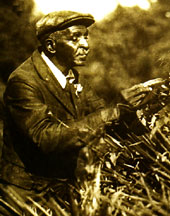 George Washington Carver on a daily nature walk (Photo courtesy of Tuskegee University)
George Washington Carver on a daily nature walk (Photo courtesy of Tuskegee University)
George Washington Carver's desire to do something significant with his life should be an inspiration to those with an I-can't attitude. In spite of what was dealt him, or because of it, he believed that his role should be to do the greatest good to the greatest number of 'my people' possible...... George should be known as more than just the "peanut man" and should be afforded more of the kudos reserved for the more popular black American leaders.
Because of the collaborative effort of the employees of the George Washington Carver National Monument and the Carver Birthplace Association, George's life is better understood. In their new book, George Washington Carver: His Life and Legacy (Donning Company, 2010) they reveal that much of George's attitude came from the nurturing he received from a white woman named Susan Carver, wife of Moses Carver who owned a farm in Diamond Grove, Missouri. She also had owned George's mother Mary at a time during the Civil War when slavery was acceptable in the South. The book points out that George never knew his father said to be a slave on a neighboring farm who died shortly after his birth and that nothing is known of the courtship of Mary who gave birth to as many as five children. Documents do show, however, that Mary and George were kidnapped and that only George was recovered after Moses sent a scout from the Union Army in search of them. The authors acknowledge that George did have the companionship of his older brother Jim said to have died of smallpox in 1883 and buried near Seneca, Missouri, another recognizable location to Joplin area residents.
On the Carver farm George was given the freedom to explore native plants. He tendered a garden on the sly, according to the authors, because as they quote him, it was considered foolishness in that neighborhood to waste time with flowers. This fascination with nature motivated George to better his education.
The authors show the obstacles of uncontrolled racial violence that George confronted and how he eventually befriended whites in their exclusive world. According to the authors, George's "relationships with open-minded whites raised awareness of the African American struggle," and that his "contributions in the field of education and agriculture helped impoverished farmers and others throughout the world. Yet, they conclude that George's "broader motive of service to humanity" was his greatest achievement, one that they wish to memorialize in both the book and the George Washington National Monument that showcase his struggles and achievements.
George Washington Carver: His Life and Legacy is published by The Donning Company Publishers of Virginia Beach, VA and is the newest book in their "Portrait of America" series. It is available for order from the George Washington Carver National Monument for $5.95 or at a discount for larger orders. Contact Pauline Charles by phoning (417) 325-4151 or sending an e-mail here.
The George Washington Carver National Monument is located at 5646 Carver Rd., Diamond.






Comments